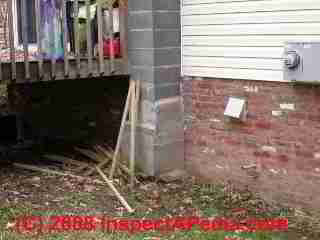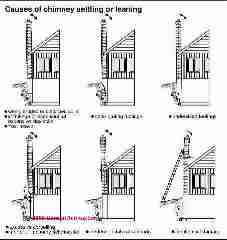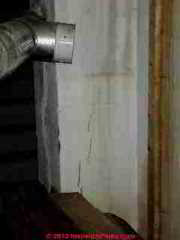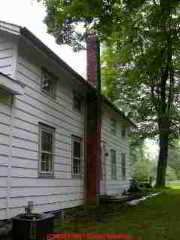 What Causes Leaning Moving Separating Chimneys?
What Causes Leaning Moving Separating Chimneys?
- POST a QUESTION or COMMENT about the causes of chimney separation from the building, cracking, leaning, or other chimney movement problems
Diagnose movement in chimneys:
This article describes chimney inspection procedures and critical chimney defects which can be observed from outdoors at ground level. We begin with the detection of chimney movement, its causes, its symptoms.
These articles continue with other chimney defects that can be found by visual inspection from outdoors at ground level, then from an on-roof inspection, followed by indoor inspections and ending with chimney-flue interior inspections.
InspectAPedia tolerates no conflicts of interest. We have no relationship with advertisers, products, or services discussed at this website.
- Daniel Friedman, Publisher/Editor/Author - See WHO ARE WE?
What Causes Chimney Movement, Leaning, or Separation from a Building?
These articles on chimneys and chimney safety provide detailed suggestions describing how to perform a thorough visual inspection of chimneys for safety and other defects. Chimney inspection methods and chimney repair methods are also discussed.
Defective or Missing Chimney Footings Cause Cracks, Leaning, Movement, or Collapse
Masonry chimneys represent a heavy concentrated load on the soil or support structure. Therefore, proper footing support is critical and is generally separated from the building footings except possibly at the exterior wall.
It should not come as a surprise that some masonry chimneys are constructed with an inadequate footing, or no supporting footing whatsoever. Future settlement, movement, tipping, or separation of the chimney from the building is certainly likely in such installations.
Even a casual inspection from outside would raise the question about the absence of a footing for the chimney shown in our photo. You will notice the erosion of soil from below a little concrete skirt around the chimney base of this concrete block chimney.On occasion you may find that the chimney was built on bedrock, taking advantage of a natural footing. Inspecting in a crawl space or basement where the bedrock is visible may reduce the anxiety of the inspector in such cases.
[Click to enlarge any image]
Homes built upon dry-laid stone foundations may have a chimney installed with its base sitting atop the foundation wall itself. Those chimneys might be stable, but be sure to review our warnings about dead end flues that are usually in use where such chimneys were built with no extension very far below ground level.
We provide a series of articles on diagnosing chimney cracks and movement include Chimney Movement - Causes,
then CHIMNEY MOVEMENT, ONGOING vs STATIC where we describe determining whether chimney movement is ongoing.
A Catalog of the Causes of Chimney Movement
Carson Dunlop Associates [at REVIEWERS] sketch shows a number of common causes of chimney movement. Understanding the cause of movement informs the choice of repair methods. Three of these have to do with the chimney footing:
- Bad soils supporting the chimney footing, combined with weak or eroded soils, frost heaves, or expansive clay soils under the footing; if a chimney was added after the building construction and backfill were complete there is an increased chance that the chimney footing was placed on soft backfill that later settled.
- Deteriorated chimney footing, perhaps from water, frost, poor quality of concrete used, loose stone construction, placement on top of an unstable stone foundation wall
- Undersized chimney footing, such as a footing that does not project sufficiently past the chimney base to support its weight on the soil below, or a footing that was cast too thin, resulting in breakage.
- Excessive chimney corbelling (stair-stepped brick work) - often found inside attics of older homes - look closely at the junction between the beginning of the corbelled chimney section and the top of the last course of vertical brick masonry for gaps. Often this detail is hard to see because it is at or inside the attic floor.
- Deteriorated chimney mortar leading to loose or falling chimney sections
- Missing or inadequate lateral support tying the chimney to the structure. Lateral support stabilizes a tall chimney, but lateral support is unlikely to handle the weight of a falling or leaning masonry chimney caused by other conditions in this list.
- Mechanical damage to the chimney - such as leaning a ladder against a tall flue, perhaps combined with weight of a scaffold during chimney repair or roof repair work, or by falling tree limbs.
Other chimney movement gaps include caulk or even wood or metal flashing covering the gap between the chimney and the building.
If the chimney has recently moved, say since the last "repair" you will see a new gap or you may see a line on the chimney where a sealant that used to touch the building has torn away from the building but remained attached to the chimney side.
Such chimneys are unlikely to be safe, probably need major repairs, and are likely to need to be replaced entirely.
If we see a leaning or moving chimney that already has been re-lined we speculate that it may have been inspected and repaired but we'd still want to know just what was done.
If the chimney moved further after the liner was installed, connections between vented appliances or a woodstove and the chimney flue liner could have opened and thus might be unsafe.
See CURVED BRICK CHIMNEYS, SULPHATION for a description of apparent chimney movement caused by the combination of a missing flue liner and sulphation.
Cracked Concrete Block Chimneys
Both outdoors and indoors we may also see chimney cracks which could be due to chimney movement (introduced above) or due to compression loads or other chimney construction problems (just below).
Cracked concrete block chimneys: Our photo at left shows dangerous cracking indoors in a concrete block chimney used to vent a heating appliance. (You might also notice that the barometric damper is not level - a much simpler problem to correct.) As a chimney leans away from the house we might find several problems:- Damaged, unsafe chimney liner
- Damaged, unsafe fireplaces where the chimney has pulled the firebox away from the building or created dangerous openings around the fireplace into the building structure, risking both sparks (and fire) or air leaks (and inability to control the draft).
- Leaks into the building walls
- Unsafe fireplaces in the building: hearth cracks, fireplace side cracks, chimney damage all present risks of sparks or smoke entering the building cavities, a fire and flue gas risk. Check for evidence of movement at the fireplace.
Also see CHIMNEY CRACK DETECTION & DIAGNOSIS
The usual repair is to remove and replace the chimney, though in some cases it may be possible to re-line a chimney and to jack an intact masonry chimney back to level and repair its connections into the building.
Goofy Moving Chimney Repairs and Attempts to Hide Chimney Movement
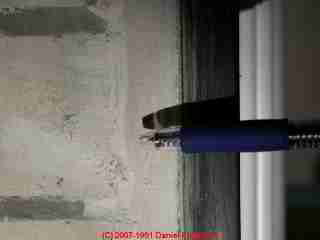
Attempts to hide chimney movement can be dangerous since if there is a safety problem the building owner or inspector may not pick up its clues.
The fresh and thick band of caulk between the chimney and the wall as shown in this photograph were traced to a chimney separation that had been "repaired" simply by more caulking at the wall.
Because caulk is flexible, if it has been recently applied caulking may hide an ongoing chimney movement problem. But even if the chimney is no longer moving (or we think it is not moving) an inspection for flue safety and fireplace safety are essential.
In the next article in this series, Ongoing Chimney Movement, we provide a detailed example of a chimney which probably moved continually over many years, and which produced a wide gap between the chimney side and the building.
at CHIMNEY MOVEMENT, ONGOING vs STATIC we continue this article with a case reporting evidence of ongoing chimney movement, repeated repairs, and the need to remove and rebuild a large masonry chimney.
...
Reader Comments, Questions & Answers About The Article Above
Below you will find questions and answers previously posted on this page at its page bottom reader comment box.
Reader Q&A - also see RECOMMENDED ARTICLES & FAQs
Question: chimney damage or movement caused by chimney sweep work?
I had a chimney sweep on my roof last week He cut the top off one of the clay liners to accommodate a chimney cap. After his departure I noticed the top of the chimney was moved away from the house about 1 inch. Could the chimney sweep leaning on the chimney produce enough force to move the chimney? I am absolutely sure the chimney was not away from the house prior to his work. Thanks for any help you may provide. - M.H., Woburn MA
Reply: check the chimney flue for safety ASAP
A competent onsite inspection by an expert usually finds additional clues that help accurately diagnose a problem such as the chimney movement you describe. And while I express opinions and give advice below, we're talking email here - not a substitute for an onsite expert. An unsafe chimney (yours, if it moved, may be unsafe) is a fire and carbon monoxide hazard risking fire or even a fatality. Sorry to sound so "scary" but when we're talking about chimneys by email I feel obligated to worry about safety first.
That said, here are some things to consider:
Watch out: your first priority is safety: Assuming that your chimney is in use, perhaps by your heating system or a fireplace, the first priority is to make sure that the chimney is safe to use. Do not delay in resolving that question. I offer "how to" advice in these notes.
- If the chimney has moved or is damaged in any way, part of the "repair" (if it can be repaired) would normally require an understanding of the cause of the damage - otherwise a repair may be ineffective. For example, installing a poured masonry liner in an unsafe masonry chimney might not be not an effective repair if the chimney lacks a sound footing.
- *Normally* working on a masonry chimney (as I infer from your description) should not cause it to move away from the building, but if the chimney were improperly supported or constructed that's certainly possible. I once nearly fell off of a roof when I leaned for a moment against a tall brick chimney that was not attached to the building.
- And if the "cutting" of the top clay liner involved banging about with a hammer and masonry chisel
- That might have disturbed the chimney. I accept that you are confident that the chimney had not moved prior to the work recently performed, though in all such cases I caution that there is a phenomenon I've seen many times over a long career, as perhaps have you: at times there was and remains is a pre-existing condition at a building that no one ever noticed until something else caused them to direct their attention in that direction. Then it appears that the condition is "new" - it may not be. And an expert can usually find compelling evidence to support the "new" vs "older" condition of a defect. I could suggest some methods if needed.
Any chimney of any type that has moved raises very important safety questions.
- You should check the flue interior for damage and debris - start at the chimney base or cleanout door and look for freshly-broken scraps of chimney liner tile and also consider that if a chimney is or has been moving around it may be unsafe - having opened cracks into the building that could lead to a fire or flue gases entering the structure.
- A professional chimney sweep, perhaps one certified by the National Chimney Sweeps Guild, can inspect the flue for safety - I'd make this a priority, and I'd be reluctant to rely on the fellow who installed the cap as he may not be a neutral professional. You can also call your local fire department for advice.
- Meanwhile what you can do immediately is make sure you have working CO detectors and smoke detectors properly installed in your home
I would like to see sharp photos of the chimney cap installation, the chimney from roof and from ground, of any scraps you find, any cracks you observe, and I can offer further comment - but an onsite inspection by an expert is most important rather than my email views.
Finally, your chimney inspector might want to be familiar with NFPA 921 - if s/he is someone who is a professional and who works with fire and explosion investigations they probably know this "Guide for Fire and Explosion INvestigations". The current edition of NFPA 921 can be purchased online at NFPA 921: Guide for Fire and Explosion Investigations (Amazon) or directly from the NFPA at nfpa.org/aboutthecodes/AboutTheCodes.asp?DocNum=921&cookie_test=1 - listed at our references as well: [8]
Comments:
(Sept 7, 2012) Terrific website! said:
You have such a helpful website. It allows me to talk intelligently with my chimney repair people. Our chimney has been an ongoing source of woe ever since we moved in. Crown had been rebuilt, stone chimney had been repointed. Less than 5 years later we are doing it again.
Mod notes: see also STONE CHIMNEY FLASHING LEAKS
(Jan 31, 2013) Geoff said:
Hi - great articles. I'm here because I'm worried about my chimney. I bought a house, and the chimney seemed fine, but needed some exterior masonry work on some cracked cement casing. The mason decided to wrap the whole thing in a mesh wire, and put a whole new layer of cement. It seems that since this work was done, there is a crack developing in the interior wall of the house on the wall adjacent to the chimney, plus a crack on the chimney wall by the window.
Im wondering if the added weight of the repair could be causing this. There was no visible evidence of leaning or cracking before the work was done. I have to get in the crawlspace next to check the foundation area under the chimney and see what I see. I'm bumming out.
Question:
(Oct 6, 2012) Richard Prussack said:
I was recently flooded by Hurrican Irene. My chimney has separated from my house by three to four inches at the peak of the house. Could the flooding that we experienced have in some way caused the the movement noted above, or exaserbated a poorly laid chimney foundation The houseisroughly 70 years old
Reply:
Richard,
Yes, especially if the house, despite it's age, had never been surrounded by flood waters before, flooding could cause soil settlement or wet earth pressures that disturbed the chimney footing.
Watch out: with that much movement the chimney may well be unsafe to use, risking fire ormtoxic gas leaks into the home.
...
Continue reading at CHIMNEY MOVEMENT CLUES, INDOORS or select a topic from the closely-related articles below, or see the complete ARTICLE INDEX.
Or see these
Chimney Leaning, Damage, Repair Articles
- CHIMNEY COLLAPSE RISKS, REPAIRS
- CHIMNEY CRACK DIAGNOSIS
- CHIMNEY DAMAGE by LEAKS & FROST
- CHIMNEY INSPECTION CHECKLIST
- CHIMNEY INSPECTION, FLUE INTERIOR
- CHIMNEY INSPECTION from GROUND
- CHIMNEY INSPECTION OUTDOORS
- CHIMNEY INSPECTION INDOORS
- CHIMNEY INSPECTION ROOFTOP
- CHIMNEY LEANING, SEPARATION, MOVEMENT
- CHIMNEY RE-LINING CHOICES
- CHIMNEY REPAIR METHODS
- FLASHING, CHIMNEY MISTAKES & LEAKS
Suggested citation for this web page
CHIMNEY MOVEMENT CAUSES at InspectApedia.com - online encyclopedia of building & environmental inspection, testing, diagnosis, repair, & problem prevention advice.
Or see this
INDEX to RELATED ARTICLES: ARTICLE INDEX to CHIMNEYS & FLUES
Or use the SEARCH BOX found below to Ask a Question or Search InspectApedia
Ask a Question or Search InspectApedia
Try the search box just below, or if you prefer, post a question or comment in the Comments box below and we will respond promptly.
Search the InspectApedia website
Note: appearance of your Comment below may be delayed: if your comment contains an image, photograph, web link, or text that looks to the software as if it might be a web link, your posting will appear after it has been approved by a moderator. Apologies for the delay.
Only one image can be added per comment but you can post as many comments, and therefore images, as you like.
You will not receive a notification when a response to your question has been posted.
Please bookmark this page to make it easy for you to check back for our response.
IF above you see "Comment Form is loading comments..." then COMMENT BOX - countable.ca / bawkbox.com IS NOT WORKING.
In any case you are welcome to send an email directly to us at InspectApedia.com at editor@inspectApedia.com
We'll reply to you directly. Please help us help you by noting, in your email, the URL of the InspectApedia page where you wanted to comment.
Citations & References
In addition to any citations in the article above, a full list is available on request.
- [3] NFPA 211 - Standards for Chimneys & Fireplaces, NFPA 211: Standard for Chimneys, Fireplaces, Vents, and Solid Fuel-Burning Appliances, 2006 Edition (older editions and standards are found at the same bookstore)
- [4] NFPA #211-3.1 1988 - Specific to chimneys, fireplaces, vents and solid fuel burning appliances.
- [5] NFPA # 54-7.1 1992 - Specific to venting of equipment with fan-assisted combustion systems.
- [6] GAMA - Gas Appliance Manufacturers' Association has prepared venting tables for Category I draft hood equipped central furnaces as well as fan-assisted combustion system central furnaces.
- [9]Fire Inspector Guidebook, A Correlation of Fire Safety Requirements Contained in the 1987 BOCA National Codes, (newer edition available), Building Officials and Code Administrators International, Inc. (BOCA), Country Club HIlls, IL 60478 312-799-2300 4th ed. Note: this document is reissued every four years. Be sure to obtain the latest edition.
- [10] New York 1984 Uniform Fire Prevention and Building Code, Article 10, Heating, Ventilating, and Air Conditioning Requirements
- [11] New York 1979 Uniform Fire Prevention & Building Code, The "requirement" for 8" of solid masonry OR for use of a flue liner was listed in the One and Two Family Dwelling Code for New York, in 1979, in Chapter 9, Chimneys and Fireplaces, New York 1979 Building and Fire Prevention Code:
- [12] "Top Ten Chimney (and related) Problems Encountered by One Chimney Sweep," Hudson Valley ASHI education seminar, 3 January 2000, contributed by Bob Hansen, ASHI
- Our recommended books about building & mechanical systems design, inspection, problem diagnosis, and repair, and about indoor environment and IAQ testing, diagnosis, and cleanup are at the InspectAPedia Bookstore. Also see our Book Reviews - InspectAPedia.
- Chimney Inspection Checklist, Carson Dunlop, Associates, Toronto, Ontario
- Chimney & Stack Inspection Guidelines, American Society of Civil Engineers, 2003 - These guidelines address the inspection of chimneys and stacks. Each guideline assists owners in determining what level of inspection is appropriate to a particular chimney and provides common criteria so that all parties involved have a clear understanding of the scope of the inspection and the end product required. Each chimney or stack is a unique structure, subject to both aggressive operating and natural environments, and degradation over time. Such degradation may be managed via a prudent inspection program followed by maintenance work on any equipment or structure determined to be in need of attention. Sample inspection report specifications, sample field inspection data forms, and an example of a developed plan of a concrete chimney are included in the guidelines. This book provides a valuable guidance tool for chimney and stack inspections and also offers a set of references for these particular inspections.
- Chimney Safety Institute of America - Chimney Fires: Causes, Effects, Evaluation
- National Chimney Sweep Guild - Yellow Pages of Suppliers
- In addition to citations & references found in this article, see the research citations given at the end of the related articles found at our suggested
CONTINUE READING or RECOMMENDED ARTICLES.
- Carson, Dunlop & Associates Ltd., 120 Carlton Street Suite 407, Toronto ON M5A 4K2. Tel: (416) 964-9415 1-800-268-7070 Email: info@carsondunlop.com. Alan Carson is a past president of ASHI, the American Society of Home Inspectors.
Thanks to Alan Carson and Bob Dunlop, for permission for InspectAPedia to use text excerpts from The HOME REFERENCE BOOK - the Encyclopedia of Homes and to use illustrations from The ILLUSTRATED HOME .
Carson Dunlop Associates provides extensive home inspection education and report writing material. In gratitude we provide links to tsome Carson Dunlop Associates products and services.


